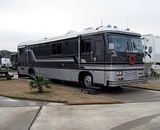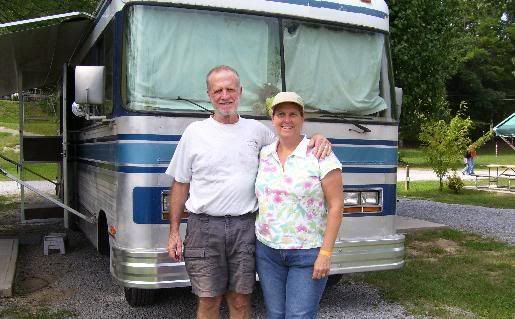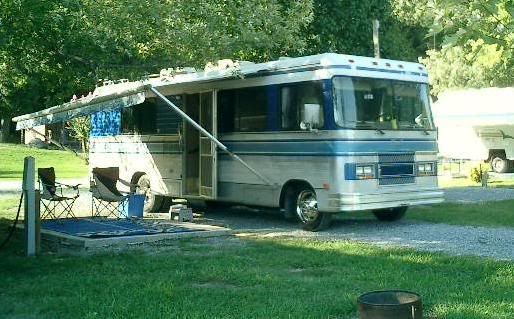Page 1 2
Go to...  | Start A New Topic  | Search  | Notify  | Tools  | Reply To This Topic  |  |
 6/12 6/12Formally known as "Humbojb"  |
Our converter does a nice job of keeping the house batteries charged. But it does not charge the one starting battery. Can we wire the converter to do both the house batteries and the starting battery? If we did, would we have to disconnect the charger from the starting battery before starting the engine since the alternator would want to do that job? thanks Jim
| |||||||||||
|
 6/12 6/12Formally known as "Humbojb"  |
I talked to Progressive Dynamics and they said that you can do one of two thing. First, run a separate line from the converter to the chassis battery and let it rip. Second, run a #10 wire from the positive terminal of one of the house batteries to the positive terminal of the chassis battery, and let it rip. Either way, make sure you disconnect the wire to the chassis battery before you start the engine. You can do this by putting a switch in the line of option #1 or merely by taking off the jumper wire in option # 2. I chose option #2, took 5 minutes and everything is going fine now. Jim
| ||||||||||||
|
Official Barth Junkie |
I meant to reply sooner but you've got the idea. Our GMs usually have a battery isolator for the alternator, allows charging both batteries from the engine alternator. Once the engine is off, the batteries are isolated, so charging the house batteries won't normally charge the start battery also. I haven't had much trouble with this since I start the coach now and then and so far the start battery has not run down. However, extended storage, etc would motivate one to charge the start battery now and then. Essentially, then, we are temporarily bypassing the isolator. I was going to suggest the same solution you decided, i.e. connect the batteries and allow the house charger to do both, with some reservations: 1. If the start battery is really low, it could draw considerable current (through the jumper) from both the PD convertor AND the house batteries. Extreme case the jumper wire could get hot. 2. Be sure to disconnect the jumper before starting. Otherwise, some of the starter load could come from the house batteries via the jumper, again getting it hot. 3. Because the battery sets are often different types, (ie deep cycle versus starting types) they may require different "float" voltages to optimize their charge. When jumpered together, they can't do this. Once the start battery is charged, I would disconnect it, rather than leave it for extended period. (With the PD convertor it's probably OK but you never know.) Better to charge than not, for sure. Lead acid cells don't like being discharged for long. 9708-M0037-37MM-01 "98" Monarch 37 Spartan MM, 6 spd Allison Cummins 8.3 325+ hp | |||
|
For me, the most convenient solution was to pick-up a Battery Tender off Ebay for about $25, plug it into the 110v rec at the driver's seat and snake it thru the doghouse to the engine battery. Plugged into shore power, the PD converter cares for the chassis battery & supplies power for the Battery Tender. I like the different size & age batteries having their own charging source independent of each other.... | ||||
|
 9/09 9/09 |
Sorry for not posting this earlier. I had a device called Trik-L-Start recommended to me and I am now using it. It has been doing an excellent job at keeping the chassis batteries charged and has been on my Regency for over a year now. Here is a link to the device. Trik-L-Start Lance & Sue Walton Previous owner of a 1993 38ft Regency Cummins 6CTA8.3 300HP Allison MD3060 Transmission Spartan Chassis Loveland, CO | |||
|
 6/12 6/12Formally known as "Humbojb"  |
How would one know if the set up (isolator) allows the alternator to charge the house batteries while the Barth is running?
| ||||||||||||
|
Captain Doom |
Voltmeter. Check the voltage with the engine stopped and with it running. Rusty '94 28' Breakaway: MilSpec AMG 6.5L TD 230HP Nelson and Chester, not-spoiled Golden Retrievers Sometimes I think we're alone in the universe, and sometimes I think we're not. In either case the idea is quite staggering. - Arthur C. Clarke It was a woman who drove me to drink, and I've been searching thirty years to find her and thank her - W. C. Fields | |||
|
 6/12 6/12Formally known as "Humbojb"  |
| ||||||||||||
|
Official Barth Junkie |
The answer is not as simple as it sounds. I was planning to address isolator issues in a future post, but... If your system is like mine, the alternator output goes to a diode splitter (isolator) then to each battery set. On mine the isolator is mounted on the pass side, high on the firewall. It has cooling fins and three large terminal posts which the wires attach to. If you see it, you have one! As far as voltage goes... Problem is: the 60 amp GM alternator does not have a separate voltage sensing wire. There is a .6 V drop through the isolator for each battery leg. The internal alternator regulator senses the voltage at the output leg of the alternator and regulates energy to maintain correct voltage at that point. The batteries always see .6V lees than the alternator voltage due to the isolator drop. This is not the case with most other alternators, they have a sense wire that would typically connect right at the batteries to regulate voltage at that point (downstream from the isolator.) The alternator actually maintains .6V higher to compensate for the isolator voltage drop. Getting to the point: If you have a PD or other modern battery convertor/charger, they will maintain about 13.5 to 13.8 volts at coach batteries. Because of the isolator voltage drop, when I start the engine I do not see the voltage go up. In fact, I will find at the end of the run the batteries are below 13.5 volts! (If the coach batteries are discharged, they will charge and show a voltage rise when starting engine, but not charge quite fully due to the .6V isolator drop.) I have never been a fan of this alternator. The internal regulator on the GM alternator is sealed and not adjustable. It is designed primarily for auto use, with short starting load, quick recharge for a short while, then tapering to lower rates to prevent overcharging. As the alternator heats up the output goes down. It doesn't deliver full output long enough to quickly charge both sets of batteries. Also, the lack of external voltage sensing complicates using the isolator. (It's not the isolator's fault, it's the way this alternator senses that is the problem.) I have considered upgrading to a larger alternator with separate sensing but the brackets and belts are not compatible without major reworking. Since I dropped the load on my system with the LED lighting, etc I decided to keep the alternator and modify the isolation system to eliminate the .6V drop. Much as I like the solid state isolators (very reliable!) this alternator doesn't like them. I am planning to replace the isolator with a relay to directly connect the battery sets (no voltage drop) I will have driver control of the relay, to combine when charging, disconnect otherwise. And going full circle with the thread, this also allows me to "go the other way" ie charge the starting batteries with the house convertor, by leaving the relay energized (not isolated) Stay tuned for the upcoming isolator project! (I am heading for the Sunshine Key Barth Health club and Spa next week!) 9708-M0037-37MM-01 "98" Monarch 37 Spartan MM, 6 spd Allison Cummins 8.3 325+ hp | |||
|
| ||||
|
| First Month Member |
From an earlier post: There are ways to eliminate the drawback of a silicone diode isolator. You might not even need a diode isolator. Unless you buy or build one using Schottky diodes, they rob valuable voltage from both coach and chassis batteries, limiting their usefulness and shortening their life. You might not even need an isolator at all. I do not like parallel charging of dissimilar batteries, which is what most alternator charging systems end up doing. This is incredibly inefficient, taking hours and hours to charge, since the alternator is reading the well-charged chassis battery more than the lower-charged coach batteries. If you must use the alternator to charge coach batteries in parallel, consider a relay system. This system uses an interesting method of battery isolation and paralleling. The dash switch is an SPDT CO on-off-(on) It has three wires, with the momentary side getting power from the coach battery, the on side getting power from the ignition (or acc terminal of the ignition switch), and the center being the output to the coil of the paralleling relay. So..Start the engine with the switch in off. To attempt to charge the coach battery while driving, you move the switch to the on position, which ties the batteries together while the ignition is on. You would use the momentary position to tie the batteries together when the starting battery is low. The off position is used for normal starting or to charge the chassis battery only. If the switch gets its power from the acc terminal of the ignition switch, then it can be left in on for all normal use, as the acc terminal is usually not energized until the starter is released, but that would vary with ignition switch suppliers. The batteries are not paralleled when the ignition is off. This system combines the function of the isolator and the paralleling solenoid without the reduced charging voltage of the isolator. And there are fewer parts and connections than a system with both an isolator and a paralleling relay. However, it does not address the issue of charging a low and a charged battery in parallel. Warning: Rant follows. I am not a fan of charging coach batteries by the engine alternator, particularly through an isolator. If I wanted to do that, I would have a Perko make-before-break switch in the charging line to allow the alternator to see only the coach batteries and respond to their needs only. When the typical motor home with an isolator tries to charge both truck and coach batteries in parallel it responds to the highest battery and the result is a long slow charge for the lower batteries, usually the coach batteries. A heavier alternator never really gets to show its stuff in such a setup. The Winnebago relay solution is elegant in its simplicity, and at least avoids the diode-induced voltage loss. An isolator drops the charging voltage by around .7 volts, which can result in a sulfated battery with a short service life unless or at least three-staged after the trip. Batteries that are charged by an alternator and are not regularly fully topped off do not last as long as batteries that are properly fussed over. I never parallel my coach and chassis batteries. The alternator charges the chassis battery, as God, Ulrich Zwingli and Charles Kettering intended, and the genset or solar panels charge the coach batteries. End of parallel charging and isolator rant. . 84 30T PeeThirty-Something, 502 powered | |||
|
Official Barth Junkie |
Like I said, the answer is not as simple as it seems! I was hoping Bill would jump in. As he states, the charging of multiple sets of different batteries is not straightforward. I will be tying the alternator permanently to the start battery (Kettering, et al weren't no fools) with relay shunt to connect the sets when needed. A transfer relay would be even better... I have never needed the parallel start feature and the current required would demand very large wires and contactor rating. My system will only be used to allow alternator charging of the coach batteries when necessary, and maybe charging the start batteries via the coach convertor in a pinch. Topping off with the PD convertor should help now and then. So many options... 9708-M0037-37MM-01 "98" Monarch 37 Spartan MM, 6 spd Allison Cummins 8.3 325+ hp | |||
|
| First Month Member |
As a side issue, we now have no coach batteries and no chassis batteries. Just four T-105 batteries. They do the dual duty of chassis and coach batteries. They are charged by alternator, solar, or Iota. This was not done for electrical considerations, but mandated by space limitations. Barth made my slide out tray just large enough for four golf cart batteries. I had to cut a little to clear the battery posts to assure an uneventful sliding in and out. . 84 30T PeeThirty-Something, 502 powered | |||
|
| First Month Member |
The Ford relay installed by Barth is up to the job. The 2 ga wire installed by Barth is up to the job. The OEM parallel start feature can also be used to get home with a dead alternator. Just hold it down and drive with the genset running. . 84 30T PeeThirty-Something, 502 powered | |||
|
Hi all, I hope I am not intruding--after reading some of the comments on this forum about Delco alternators and isolators I do have some comments that I think maybe of value. First,on any Delco internal regulated alternator like a 7127 or a 7273 the "sensing" terminal in the one marked #2 and usually has a large red wire--that is the wire that tells the alternator the system voltage. When that wire is re-directed to the #2 terminal on the isolator the alternator will charge at appox. 15.2 which will compensate for the inherant voltage drop through the isolator. The main reason that solenoids are no longer used to control the connecting of multiple batteries is what we call "in-rush" voltage--this causes the solenoid contacts to burn and fail. I will stop for now but needless to say I have answers for most of your problems if you are interested. My business--Smith Auto Electric,LLC www.smithae.com has been in business for 67 years. I will try to monitor this forum until I can help solve your problems and of course I sell these products as well. Thanks,Jim | ||||
|
| Powered by Social Strata | Page 1 2 |
| Please Wait. Your request is being processed... |
|
This website is dedicated to the Barth Custom Coach, their owners and those who admire this American made, quality crafted, motor coach.
We are committed to the history, preservation and restoration of the Barth Custom Coach.
We are committed to the history, preservation and restoration of the Barth Custom Coach.



